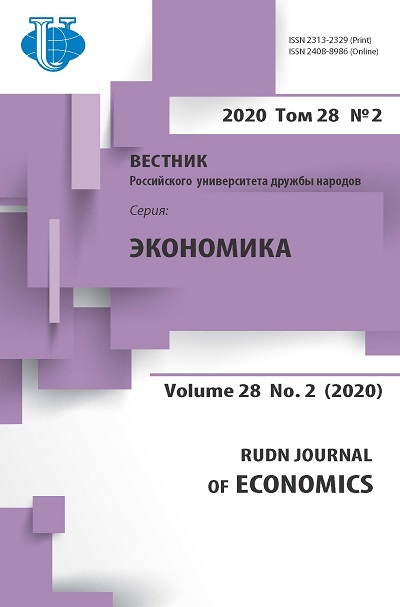Risks and benefits of small hydropower development: Chinese experience and Russian practice
- Authors: Chernyaev M.V.1
-
Affiliations:
- NRA International GmbH
- Issue: Vol 28, No 2 (2020)
- Pages: 300-314
- Section: Industrial organization markets
- URL: https://journals.rudn.ru/economics/article/view/23897
- DOI: https://doi.org/10.22363/2313-2329-2020-28-2-300-314
Cite item
Full Text
Abstract
The inevitable depletion of traditional energy sources attracts a strong interest in the development of renewable energy technologies around the world. Territorial features and abundance of water resources in Russia have a great potential for small hydropower development, but statistics show that there is no high practical interest in this area. A comparative analysis of the features of the Russian and Chinese energy systems indicates the presence of certain problems in the small hydropower industry of Russia connected with the lack of a strategic understanding of the prospects for the development of the industry at the state level. This situation naturally leads to an increase in investment risks. The purpose of the present research is to determine the conditions that can make the construction of small hydropower plants attractive to investors and lead to the formation of the market of the appropriate technological equipment. Official statistics, planning documents, expert publications in the media and scientific magazines, as well as the author's comparisons of the Russian and Chinese small hydropower regulation measures have been used in the process of analyzing the Russian energy development.
About the authors
Maksim V. Chernyaev
NRA International GmbH
Author for correspondence.
Email: m.chernyaev@mail.ru
PhD, Associate Professor, expert on CIS and Russia “NRA International GmbH” (Austria, Vienna), adviser on foreign economic activity of the oil service company “Novas Energy Services”, Vice President of International Cooperation and Youth Policy of the International Academy of Technological Sciences (MATN).
Wipplingerstraße 34, Vienna, A-1010, Republic of AustriaReferences
- Abd-El Monsef, H., Smith, S.E., & Darwish, K. (2015). Impacts of the Aswan High Dam After 50 Years. Water Resour. Manag. 29, 1873–1885. https://doi.org/10.1007/s11269015-0916-zs
- Ashourian, M.H., Cherati, S.M., Mohd Zin, A.A., Niknam, N., Mokhtar, A.S., & Anwari, M. (2013). Optimal green energy management for island resorts in Malaysia. Renewable Energy, Elsevier, 51(C), 36–45. Retrieved December 20 2019 from https://ideas.repec.org/ a/eee/renene/v51y2013icp36-45.html
- Basir Khan, M.R., Jidin, R., Pasupuleti, J., & Shaaya, S.A. (2015). Optimal combination of solar, wind, micro-hydro and diesel systems based on actual seasonal load profiles for a resort island in the South China Sea. Energy, Elsevier, 82(C), 80–97. Retrieved December 20 2019 from https://ideas.repec.org/a/eee/energy/v82y2015icp80-97.html
- Chernyaev, M., Grigorieva, E., Kreidenko, T., & Rodionova, I. (2019). Methodology of the process of improving the support tools for fuel and energy complex within the context of achieving energy efficiency and energy independence of the region. International Journal of Energy Economics and Policy, 9(1), 250–261.
- Deepak, K., & Katoch, S.S. (2015). Sustainability Suspense of Small Hydropower Projects: A Study from Western Himalayan Region of India. Renewable Energy, 76, 220–233.
- Fortov, V., & Popel, O. (2013). Vozobnovljaemye istochniki jenergii v mire i v Rossii [Renewable energy sources in the world and in Russia]. Jenergeticheskij vestnik, 16, 20–31. (In Russ.)
- Gomonov, K.G., Sipakova, P.O., & Chapurnaya, A.P. (2019). Introduction of microgeneration and energy-saving technologies within the concept of green economy: Foreign experience and Russia. RUDN Journal of Economics, 27(3), 442–454. http://dx.doi.org/ 10.22363/ 2313-2329-2019-27-3-442-454
- Grechukhina, I.A., Kudryavtseva, O.V., & Yakovleva, E. Yu. (2016). Jeffektivnost' razvitija rynka vozobnovljaemyh istochnikov jenergii v Rossii [The efficiency of the development of the market of renewable energy sources in Russia]. Jekonomika regiona, 4(12), 1167–1177. doi: 10.17059/2016-4-18. (In Russ.)
- Hennig, T., & Harlan, T. (2018). Shades of green energy: Geographies of small hydropower in Yunnan, China and the challenges of over-development. Global Environmental Change, 49, 116–128. https://doi.org/10.1016/j.gloenvcha.2017.10.010
- Jiang, S.Y., Zeng, H.P., & Cao, M.X. (2015). Effects of hydropower construction on spatialtemporal change of land use and landscape pattern. A case study of Jing Hong, Yunnan, China. Proceedings of the 3rd International Conference on Advances in Energy and Environmental Science (Zhuhai) (pp. 1–7). https://doi.org/10.2991/icaees-15.2015.20
- Orakhelashvili, M. (2010). Problemy razvitiya maloy gidroenergetiki. Povysheniye nadezhnosti i effektivnosti ekspluatatsii energeticheskikh ustanovok i energeticheskikh system [Problems of small hydropower development. Improving the reliability and operational efficiency of power plants and power systems]: Conference Proceedings. Retrieved October 25 2019 from www.energy2010.mpei.ru
- Riva, F., Ahlborg, H., Hartvigsson, E., Pachauri, S., & Colombo, E. (2018). Electricity access and rural development: Review of complex socio-economic dynamics and causal diagrams for more appropriate energy modelling. Energy for Sustainable Development, 43, 203–223. Retrieved December 20 2019 from https://www.sciencedirect.com/science/ article/pii/S097308261731390X?via %3Dihub
- Serhat, K. (2014). Environmental risk assessment of small hydropower (SHP) plants: A case study for Tefen SHP plant on Filyos River. Energy for Sustainable Development, 19(1), 102–110. https://doi.org/10.1016/j.esd.2013.12.010
- Small Hydropower Development and Electrification Bureau of the Ministry of Water Resources. (2017). National Statistical Annual Report on Small Hydropower. Beijing: China Statistics Press.
- State information system in the field of energy conservation and energy efficiency. (2017). The development of small hydropower in Russia, 2017. Retrieved December 25 2019 from https://gisee.ru/articles/small-hydro/24512/
- United Nations Industrial Development Organization (Vienna), International Center on Small Hydro Power (Hangzhou). The World Small Hydropower Development Report 2016. Retrieved January 12 2020 from http://www.smallhydroworld.org/menu-pages/reports/2016/
- Wang, J.-H., Tseng, S.-W., & Zheng, H. (2015). The paradox of small hydropower: Local government and environmental governance in China. The Journal of Development Studies, 51, 1475–1487. https://doi.org/10.1080/00220388.2014.973860
- Wu, Y., Wang, Y., & Chena, K. (2017). Social sustainability assessment of small hydropower with hesitant PROMETHEE method. Sustainable Cities and Society, 35, 522–537. https://doi.org/10.1016/j.scs.2017.08.034
- Yasinsky, V.A. (2011). Sovremennoe sostojanie i perspektivy razvitija maloj gidrojenergetiki v stranah SNG [Current status and development prospects of small hydropower in the CIS countries]. Otraslevoe obozrenie, 14, 21–25. (In Russ.)
- Zhang, S., Andrews-Speed, P., & Ji, M. (2014). The erratic path of the low-carbon transition in China: Evolution of solar PV policy. Energy Policy, 67, 903–912. https://doi.org/ 10.1016/j.enpol.2013.12.063















